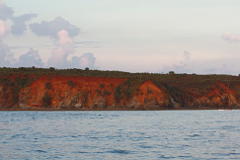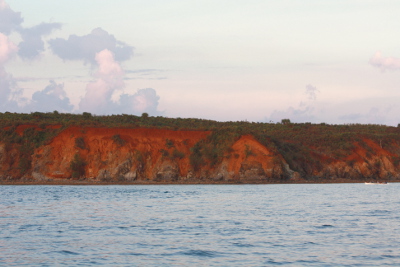Rape & Opportunity In Surigao del Norte
|
Image By Girlie Cervantes
|
I recently visited Surigao del Norte to report on tourism activities there, with a special focus on water sports. I found plenty of water sports and many new ventures in the pipeline. But what really took my breath away was the rape of Surigao over the past five years in the quest for easy money.
Jake Miranda, local hotelier and scuba diving fanatic, described Surigao del Norte as “presently suffering an identity crisis”: does it want to continue to be rapped by the global mining industry or does it want to embrace eco and adventure tourism. It cannot happily do both.
Surigao del Norte has been known as the "nickel capitol of Asia"; as you travel by boat through the islands you cannot avoid to see the evidence. On every horizon there are hillsides, sometimes whole islands, stripped bare of foliage and topsoil so that the red nickel ore can be scrapped away until only useless rock is left. There are no plans for true rehabilitation of any of the areas destroyed by the mining operations, once the ore runs out.
There are other precious minerals and metals here, none the least of which is gold; most recently it is reported that an Australian company obtained a permit to explore for diamonds . . . adding a new facet for sure to the identity crisis.
For many, the visible destruction in places is beyond comprehension and, in the ferry boat we traveled aboard, at least one person could be seen staring out at a blood-red island and was moved to mournfully sing “Ang bayan kong Pilipinas . . .” (check out the Wikipedia English translation is you are unfamiliar with the lyrics).
Surigao is truly a land of gold and flowers, where foreigners have been enticed for centuries and where those with political- or fire- power have benefited while the average Filipino has been disinherited of wealth and health. First the Spanish then the Americans and now the Chinese take so much, give so little in return and leave only barren hillsides, dry riverbeds and choking corals.
Related in this regard is the disengagement of Dinagat Island from Surigao del Norte in 2006, when it was named a separate province. Ostensibly because it qualified to be separate based on land area, population etc. The administration of Dinagat Island is defacto controlled by a fanatical religious sect that demands devotion to its leader who flaunts the law of the land, lives an extraordinarily luxurious lifestyle and dictates to his followers from a lofty mansion, set high on a hill above the island’s main town of San Jose. Since the separation of Dinagat Island from Surigao del Norte, the island’s administration has sold for profit large swathes of its trees & topsoil, and has set about stripping the under-lying minerals for export to foreign lands, leaving large areas of the island as blood red wastelands. Dinagat Island may soon be brought back under the direction of Surigao del Norte but it is doubtful that the rape of the island will cease.
How would eco/adventure tourism change the face of Surigao del Norte? First, it would inject the imported dollar into the grassroots of the community. The mining companies reward a handful of influential individuals with huge sums that are frequently reinvested outside the community; a tourist provides many local people with payment for transport, accommodation, food and guidance et al, so the income first circulates throughout the greater population before finally reaching the hands of the influential individuals. Any under-graduate economist can tell you that such grassroots-upwards circulation has a disproportionately positive benefit on GDP growth, which in turn stimulates more investment in tourism facilities.
Could Surigao del Norte offer sufficient motivation for the number of tourists required to achieve income-parity with mining? The simple answer is yes, easily . . . because so little of the income from mining actually circulates within the local community the actual tourist numbers required for parity are fewer than currently go to Boracay.
Has Surigao del Norte got more to offer than Boracay? Again, the simple answer is yes. Compared to Boracay, Surigao del Norte has more: islands, beaches, rivers, lakes, golf courses, flora, fauna, indigenous species, indigenous peoples, cleaner seas and a more interesting history. With the vocally pro-environment, pro-sustainable-development Governor Sol at the helm, there is great hope here that a page can be turned and that the new page will be filled with paragraphs of sustainable, eco/adventure tourism.
With so much opportunity I hope that Surigao del Norte will be able to develop the eco/adventure future that it could have.
If you want to read about Surigao and Dinagat water sports instead of the rape of the countryside then read the September edition of Active Boating Watersports magazine.
For more information email me at philippines@getwet-asia.com



